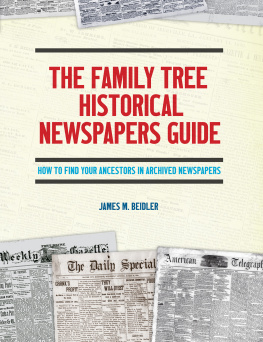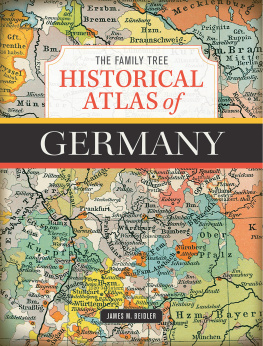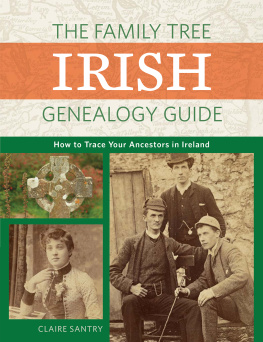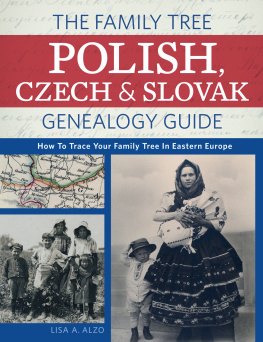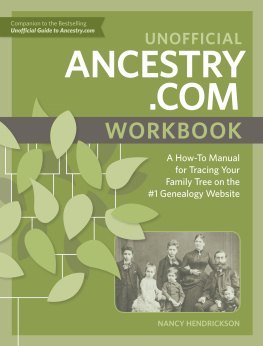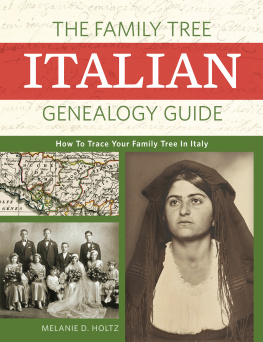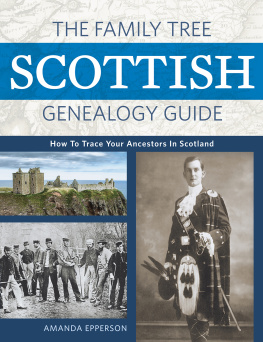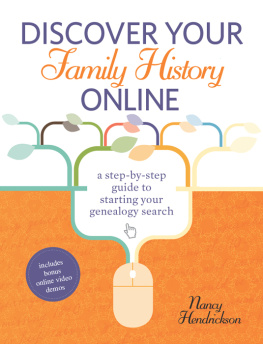The Family Tree
GERMAN
GENEALOGY GUIDE
How To Trace Your Germanic Ancestry In Europe
James M. Beidler

Cincinnati, Ohio
shopfamilytree.com
Contents
Appendices
Introduction
It was 1984, more than half my life ago, when I first began to research my family history. I was helping my mother write and edit a history of our then-250-year-old church congregation, which began as a German Reformed church.
We kept encountering names we recognized from the little bit of family history that had been handed down to my mother, and we made the fateful decision to visit the churchs old graveyard. Seeing those worn but detail-filled tombstones was all it took to get me hooked on genealogy.
In the past twenty-nine years, I have found precious few of my ancestors who were not ethnic Germans. And so German genealogy is the research about which I have learned the most. Along the way, I have learned from many people who are more skilled researchers than I will ever be and who have been formal and informal mentors: Annette K. Burgert, Hank Jones, Don Yoder, Larry O. Jensen, Jonathan Stayer, the late John T. Humphrey, Trudy Schenk, Ernie Thode, Kory Meyerink, Susannah Brooks, and Corinne and Russell Earnest are just a few of those who have had a profound effect on my learning curve over the years.
Others who have contributed assistance to this book in various ways include: Pam Stone Eagleson, Michael Lacopo, Rogert Minert, Fritz Juengling, Leslie Albrecht Huber, Baerbel Johnson, Valerie Gehr, Niels Witkamp, Eric Ric Bender, David DeKok, Rudi and Helga Daub and Terri J. Bridgwater.
Ive had so many correspondents on German genealogy over the years, but one of my first was Waleta Rupp, whose assessment of the Germans (as compared to other ethnic groups) was: At least the Germans wrote it down. And, indeed, its my hope that this book shows the wide universe of record groups available to researchers seeking ancestors of German-speaking ethnicity.
Finally, Id also like to thank the publisher and editors involved with Family Tree Magazine and this series for putting the German ethnicity as first line!
James M. Beidler
September 2013
Part 1
Linking Your Family Tree to German-Speaking Nations
Chapter 1
Your German-Speaking Heritage
It didnt take long for Germans to become part of the ethnic mix in North America. A single German man, Dr. Johannes Fleischer, accompanied the original Jamestown, Virginia, colonists. A year later, in 1608, five unnamed German glassmakers and three carpenters stepped off the ship Mary and Margaret to join the first permanent English settlement in what is today the United States. While the carpenters were brought to construct homes and the glassmakers likely worked their skill at making window panes, theres an irony that these professions both could be thought of as part of the most revered of all German industriesbeer-making (just think kegs and mugs!).
Since that auspicious beginning, nearly every wave of immigration to North America has included German-speaking people, and according to U.S. census data, more present-day Americans claim German ancestry than any other ethnicity. As impressive as this is, this statistic underestimates the number of people with German forebears, because many individuals have hidden German roots, ones in maternal lines that can be deeply obscured by surname changes after marriage.
As you read this book, youll see that having a German-speaking heritage, while common in terms of numbers, offers many distinctive opportunities for research. Theres truly a strength in numbers that makes looking for ancestors in this ethnic group a real pleasurefrom the many individuals and organizations that share the heritage and their information about it to the wealth of written documentation that has been passed down as a result of what might be called these peoples Teutonic thoroughness.
Before we get started, its important to set the scope of this book. If you know anything about German history, youll know that a unified nation of Germany didnt exist until 1871. As youll soon read, many German-speaking people immigrated to the United States long before 1871. This guide covers the areas that today are part of Germany, that were part of the German Empire from 1871 to 1918, as well as Austria and Switzerland. Well generally use the terms Germans and German-speaking interchangeably for people from the areas just described. We wont use Germanic, as a rule, because historians use that term to describe the barbarian tribes who succeeded the Roman Empire in much of Europe. These Germanic tribes were the forefathers of todays Germans and German-speaking people and also the modern English, French, Italians, Spanish, and many other groups.
This chapter will provide an overview of how German immigrants have influenced and shaped American society and help you lay a foundation for own German genealogy research.
GERMAN IMMIGRANTS IN COLONIAL AMERICA
After the slight but notable German presence in Jamestown, it would be decades before another group of German-speaking immigrants made an appearance in America and a full century before large-scale immigration began, but when that surge began, it resulted in the Germans becoming the largest free minority group in the English colonies. This first wave, followed by later immigration, spread the seeds of German culture so thoroughly throughout society that German traditions became a standard part American culture (take Christmas trees and hot dogs, for example).
The first German-dominated settlement in the United States was, appropriately, named Germantown and is now a neighborhood in Philadelphia. Germantown was founded on October 6, 1683 (now celebrated annually as German-American Day in the United States), when thirteen families settled in what was then a wilderness area. A trickle of Germans came to Pennsylvania in the remaining years of the seventeenth century and the first decade of the 1700s.
In 1709, some four thousand Germans who were primarily from the Pfalz region immigrated to London via the Dutch port of Rotterdam. From London, most of the Palatines were shipped to New Yorks Hudson Valley and enlisted in a works project for the British Navy as a way of repaying their passage. Despite deaths from hardship and disease, about 2,100 Germans arrived in the Hudson Valley in June 1710, making them the largest single immigration of people to America in the colonial period. After the works project ended, the Germans were released to fend for themselves. Many stayed in upstate New York, but others scattered throughout the Mid-Atlantic region, including a substantial number who added to the German presence in Pennsylvania.
Top Ten U.S. Cities by German Population in 1900
This data is from the 1900 U.S. census.

By the 1720s, huge numbers of German immigrants were finding cheap land and religious freedom in Pennsylvania, owned by English Quaker William Penns family, who were eager to make money from selling tracts in the colony. Pennsylvania became the center of a loosely bound community that historians call Greater Pennsylvania, which stretched from New Jersey through southeast Pennsylvania and into Maryland, Virginia, and the back country of the Carolinas. Soon Germans came to North Carolina, Virginia, and French-held Louisiana. Additional pockets of Germans developed in present-day Maine, the Carolinas, and Georgia.


